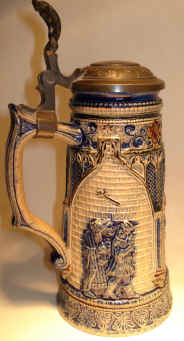
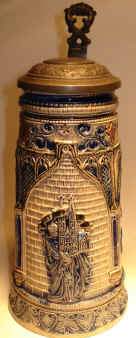
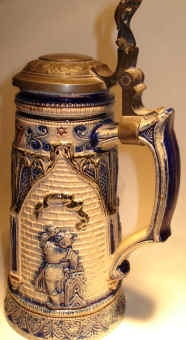
|
| ~ Fröhliche Weihnachten ~
(Happy Holy Nights = Merry Christmas) By Master Steinologist Roy De Selms |
Previous
Archives Home |
 |
 |
 |
|
When we think of Christmas, we think of the “Three Wise Men or Kings” that came from the
East following the “Star of Bethlehem”. They are depicted in the first scene on this
December 2011 “Stein of the Month”. The German term for “The Three Wise Men” is
“die drei Magi” (the three Magi). The word “Magi” is the plural of the Greek word
“Magos” and mentioned in the first New Testament written in Greek referring to
persons of the earliest religion, Zoroastrians, coming from the East (still
existing in Persia – Iran) to bring gifts of gold, frankincense and myrrh to
the newborn King of the Jews (Jesus). This word is also the source of our word "magician".
Our word “Christmas” comes from two
words “Christ” and “Mass”, but Germans use “Weihnachten” which translates
to “Holy Nights”.
The center scene shows “Germania” holding the “Cölner Dom” (Germany holding the Cologne Cathedral). The name for the city of Cologne comes from the Latin “Colonia” meaning “colony” and was one of the northernmost Roman colonies on the continent at the time of Christ. This stein is an 1860's Westerwald (western forest) copy of the “Mettlacher Dombecher” (Mettlach cathedral beakers) originally produced by Mettlach to aid in the financing of the completion of the Cologne Cathedral in 1848 to 1880. Construction of the Cathedral had begun in 1248 and stopped in about 1548. The symbolism here is meant to represent the support of all of Germany, the Catholic South and the Protestant (mainly Lutheran) North, in one magnificent show piece. |
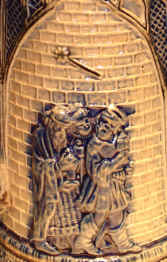 |
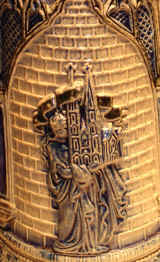 |
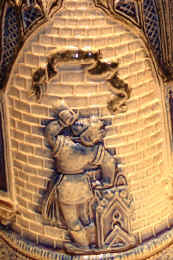 |
|
The third scene with the mason completes the trilogy (or trinity) since it
represents the masons through many generations that worked to build the cathedral.
So there are the Three Magi representing the original religious purpose for the
cathedral which was to house the "Dreikönigsschrein" (Three Kings Shrine) containing relics of the Three Wise Men
brought to Cologne in 1164, Germania representing the help and enthusiasm for this unifying project,
and the mason representing the builders.
The designer, Ludwig Foltz II, was Protestant and a Free Mason (Freimauerer) working for the Catholic Villeroy & Boch Company, which seems to have caused a little friction and Foltz's signature only appeared rarely on the pieces he designed for V&B. His signature in the original drawing was in the lower left hand of the scene in the third cartouche, but missing in all V&B beakers and pokals. However, Foltz did manage to get some symbolism in the stonemason and a few other items representing Freemasonry in his designs. The reader will note the use of German words and their translations here. This is to introduce you to an expanded translation aids section in the Reading Room of this site. More of these translations can be found in an article on “Cognates” and a new feature called "Translations Illustrated", a work in progress that provides pictures and translations of verses which appear on old German beer steins. | |
| Compliments of “Erste Gruppe” of Southern California | |
| | |